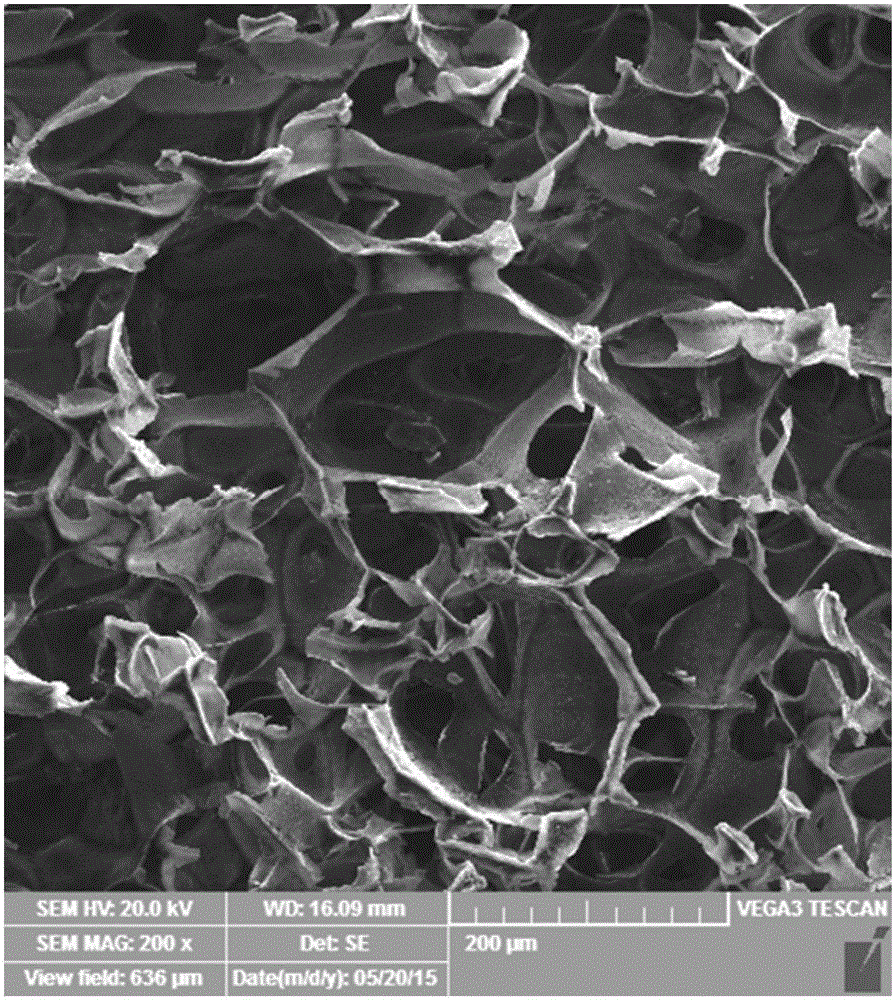GPTR (Guided Periodontal Tissue Regeneration) barrier membrane, and preparation method and application thereof
A technology for periodontal tissue regeneration and barrier membrane, applied in the field of biomedical materials, can solve the problems of weak cell adsorption, easy swelling, deformation, etc., achieve good biocompatibility, induce tissue regeneration, and simple operation steps
- Summary
- Abstract
- Description
- Claims
- Application Information
AI Technical Summary
Problems solved by technology
Method used
Image
Examples
Embodiment 1
[0031] Example 1 guides the preparation of periodontal tissue regeneration barrier membrane
[0032] (1) Preparation of soybean protein solution: Weigh 5g of soybean protein and dissolve it in 45g of distilled water, add dropwise 45g of 5% NaOH solution, stir evenly, add 25g of distilled water, and bathe in 50°C water bath for 30min. Weigh 120g of the water-bathed solution and add it dropwise to 45.3g of glacial acetic acid. During the dropwise addition, stir continuously on a magnetic stirrer. The prepared soybean protein solution is milky white without precipitation.
[0033] (2) Preparation of chitosan solution: take 20g of chitosan powder and dissolve it in 980g of 2% glacial acetic acid, stir evenly, leave it overnight until completely dissolved, and prepare 2% shell by centrifugal degassing at 7500rpm / min for 10min at 4°C Polysaccharide solution, set aside.
[0034] (3) Preparation of soybean protein / chitosan composite solution: Weigh 144.3g of the soybean protein solutio...
Embodiment 2
[0038] Example 2 In vitro degradability test of guiding periodontal tissue regeneration barrier membrane
[0039] (1) Prepare a phosphate buffer solution containing lysozyme (the content of lysozyme is 1.5 mg / mL), filter and sterilize and store at 4°C for later use.
[0040] (2) Weigh 0.1 g of the composite barrier membrane carrying the bioactive factor described in Example 1, place it in a centrifuge tube, and sterilize it by high-pressure steam;
[0041] (3) Under aseptic operation, add 10 mL of phosphate buffer solution containing lysozyme to the above centrifuge tube (2), place it on a constant temperature shaker at 37°C and shake at a low speed, and change half of the solution every day to ensure that the pH of the solution is relatively stable;
[0042] (4) Sampling and testing at 3 days, 1 week, 2 weeks, 3 weeks, 4 weeks, and 8 weeks respectively (set 3 parallel samples at each time point), gently rinse the taken out samples with double distilled water 3 times, Put in ...
Embodiment 3
[0046] Example 3 In vitro Promoting PDLSCs Proliferation and Differentiation Test of Guided Periodontal Tissue Regeneration Barrier Membrane
[0047] (1) Cut the composite barrier membrane carrying biologically active factors described in Example 1 into pieces, sterilize at 121° C. for 30 minutes by high-temperature and high-pressure steam, weigh 0.1 g of the composite barrier membrane and place it in 20 mL DMEM serum-free culture medium, and extract it for 2 days Take out the culture medium, centrifuge at 1000rpm / min for 10min, take the supernatant, which is the extract of the composite barrier membrane, and store it in a 4°C refrigerator for later use;
[0048] (2) Take the third-generation PDLSCs in a good growth state, digest them with trypsin, and prepare them at a density of 1×10 5 / mL cell suspension, inoculated into 96-well plate (200 μL per well) and 24-well plate (1 mL per well), respectively, at 37°C in 5% CO 2 Cultivate in the incubator for 24h;
[0049] (3) Afte...
PUM
 Login to View More
Login to View More Abstract
Description
Claims
Application Information
 Login to View More
Login to View More - R&D
- Intellectual Property
- Life Sciences
- Materials
- Tech Scout
- Unparalleled Data Quality
- Higher Quality Content
- 60% Fewer Hallucinations
Browse by: Latest US Patents, China's latest patents, Technical Efficacy Thesaurus, Application Domain, Technology Topic, Popular Technical Reports.
© 2025 PatSnap. All rights reserved.Legal|Privacy policy|Modern Slavery Act Transparency Statement|Sitemap|About US| Contact US: help@patsnap.com



